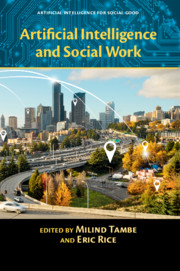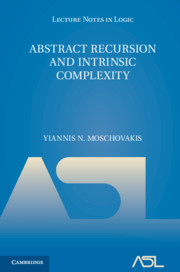Refine search
Actions for selected content:
48202 results in Computer Science
12 - SHIHbot
- from Part II
-
- Book:
- Artificial Intelligence and Social Work
- Published online:
- 24 November 2018
- Print publication:
- 29 November 2018, pp 211-230
-
- Chapter
- Export citation
3 - Using Social Networks to Raise HIV Awareness among Homeless Youth
- from Part I
-
- Book:
- Artificial Intelligence and Social Work
- Published online:
- 24 November 2018
- Print publication:
- 29 November 2018, pp 38-56
-
- Chapter
- Export citation
1 - Merging Social Work Science and Computer Science for Social Good
- from Part I
-
- Book:
- Artificial Intelligence and Social Work
- Published online:
- 24 November 2018
- Print publication:
- 29 November 2018, pp 3-15
-
- Chapter
- Export citation
RimJump: Edge-based Shortest Path Planning for a 2D Map
-
- Article
-
- You have access
- Open access
- Export citation
List of Contributors
-
- Book:
- Artificial Intelligence and Social Work
- Published online:
- 24 November 2018
- Print publication:
- 29 November 2018, pp vii-x
-
- Chapter
- Export citation
13 - Ethics and Artificial Intelligence in Public Health Social Work
- from Part II
-
- Book:
- Artificial Intelligence and Social Work
- Published online:
- 24 November 2018
- Print publication:
- 29 November 2018, pp 231-249
-
- Chapter
- Export citation
Frontmatter
-
- Book:
- Artificial Intelligence and Social Work
- Published online:
- 24 November 2018
- Print publication:
- 29 November 2018, pp i-iv
-
- Chapter
- Export citation
7 - Minimizing Violence in Homeless Youth
- from Part II
-
- Book:
- Artificial Intelligence and Social Work
- Published online:
- 24 November 2018
- Print publication:
- 29 November 2018, pp 119-135
-
- Chapter
- Export citation
ROB volume 37 issue 1 Cover and Front matter
-
- Article
-
- You have access
- Export citation
5 - Influence Maximization with Unknown Network Structure
- from Part I
-
- Book:
- Artificial Intelligence and Social Work
- Published online:
- 24 November 2018
- Print publication:
- 29 November 2018, pp 77-90
-
- Chapter
- Export citation
ROB volume 37 issue 1 Cover and Back matter
-
- Article
-
- You have access
- Export citation
10 - A Multidisciplinary Study on the Relationship between Foster Care Attributes and Posttraumatic Stress Disorder Symptoms on Foster Youth
- from Part II
-
- Book:
- Artificial Intelligence and Social Work
- Published online:
- 24 November 2018
- Print publication:
- 29 November 2018, pp 169-194
-
- Chapter
- Export citation
6 - Maximizing the Spread of Sexual Health Information in a Multimodal Communication Network of Young Black Women
- from Part II
-
- Book:
- Artificial Intelligence and Social Work
- Published online:
- 24 November 2018
- Print publication:
- 29 November 2018, pp 93-118
-
- Chapter
- Export citation
Part I
-
- Book:
- Artificial Intelligence and Social Work
- Published online:
- 24 November 2018
- Print publication:
- 29 November 2018, pp 1-2
-
- Chapter
- Export citation
Index
-
- Book:
- Artificial Intelligence and Social Work
- Published online:
- 24 November 2018
- Print publication:
- 29 November 2018, pp 255-258
-
- Chapter
- Export citation
2 - The Causes and Consequences of Youth Homelessness
- from Part I
-
- Book:
- Artificial Intelligence and Social Work
- Published online:
- 24 November 2018
- Print publication:
- 29 November 2018, pp 16-37
-
- Chapter
- Export citation
Glossary
-
- Book:
- Artificial Intelligence and Social Work
- Published online:
- 24 November 2018
- Print publication:
- 29 November 2018, pp 250-254
-
- Chapter
- Export citation

Artificial Intelligence and Social Work
-
- Published online:
- 24 November 2018
- Print publication:
- 29 November 2018

Abstract Recursion and Intrinsic Complexity
-
- Published online:
- 23 November 2018
- Print publication:
- 06 December 2018
